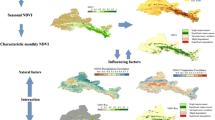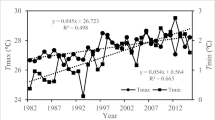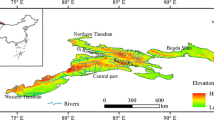Abstract
Temporal and spatial response characteristics of vegetation NDVI to the variation of temperature and precipitation in the whole year, spring, summer and autumn was analyzed from April 1998 to March 2008 based on the SPOT VGT-NDVI data and daily temperature and precipitation data from 205 meteorological stations in eastern China. The results indicate that as a whole, the response of vegetation NDVI to the variation of temperature is more pronounced than that of precipitation in eastern China. Vegetation NDVI maximally responds to the variation of temperature with a lag of about 10 days, and it maximally responds to the variation of precipitation with a lag of about 30 days. The response of vegetation NDVI to temperature and precipitation is most pronounced in autumn, and has the longest lag in summer. Spatially, the maximum response of vegetation NDVI to the variation of temperature is more pronounced in the northern and middle parts than in the southern part of eastern China. The maximum response of vegetation NDVI to the variation of precipitation is more pronounced in the northern part than in the middle and southern parts of eastern China. The response of vegetation NDVI to the variation of temperature has longer lag in the northern and southern parts than in the middle part of eastern China. The response of vegetation NDVI to the variation of precipitation has the longest lag in the southern part, and the shortest lag in the northern part of eastern China. The response of vegetation NDVI to the variation of temperature and precipitation in eastern China is mainly consistent with other results, but the lag time of vegetation NDVI to the variation of temperature and precipitation has some differences with those results of the monsoon region of eastern China.
Similar content being viewed by others
References
Braswell B H, Schimel D S, Linder E et al., 1997. The response of global terrestrial ecosystems to interannual temperature variability. Science, 278: 870–873.
Brian D. Wardlow, Stephen L. Egbert, 2008. Large-area crop mapping using time-series MODIS 250m NDVI data: An assessment for the U.S. Central Great Plains. Remote Sensing of Environment, 112(3): 1096–1116.
Chen Shupeng, Tong Qingxi, Guo Huadong, 1998. Research on mechanism of remote sensing information. Beijing: Science Press. (in Chinese)
Chen Xiaoguang, Li Jianping, Li Zhijun et al., 2007. Vegetation coverage and its relation with climate change in Qinghai Lake area. Journal of Desert Research, 27(5): 797–804. (in Chinese)
Chen Yunhao, Li Xiaobing, Shi Peijun, 2001. Variation in NDVI driven by climate factors across China, 1983–1992. Acta Phytoecologica Sinica, 25(6): 716–720. (in Chinese)
Fang Jingyun, Piao Shilong, He Jinsheng et al., 2004. Increasing terrestrial vegetation activity in China, 1982–1999. Science in China (Series C), 47: 229–240.
Fu Congbin, Wen Gang, Xie Li et al., 2002. The diagnosis and simulation studies on climate and ecosystem interactions in East Asia monsoon region. Journal of Nanjing University (Natural Sciences), 38(3): 281–294. (in Chinese)
Fung T, Siu W, 2000. Environmental quality and its changes, an analysis using NDVI. International Journal of Remote Sensing, 21(5): 1011–1024.
Habib Aziz Salim, Chen Xiaoling, Gong Jianya, 2008. Analysis of Sudan vegetation dynamics using NOAA-AVHRR NDVI data from 1982–1993. Asian Journal of Earth Sciences, 1(1): 1–15.
Ichii K, Kawabata A, Yamaguchi Y, 2002. Global correlation analysis for NDVI and climatic variables and NDVI trends: 1982–1990. International Journal of Remote Sensing, 23: 3873–3878.
Li Xiaobing, Shi Peijun, 2000. Sensitivity analysis of variation in NDVI, temperature and precipitation in typical vegetation types across China. Journal of Plant Ecology, 24(3): 379–382. (in Chinese)
Lin Hui, Xiong Yujiu, Wan Lingfeng et al., 2007. Temporal and spatial variation of MODIS vegetation indices in Hunan province. Chinese Journal of Applied Ecology, 18(3): 581–585. (in Chinese)
Liu Shaojun, Huang Yanbin, Li Tianfu et al., 2007. Study on driver factors of vegetation index based on MODIS in Hainan Island. Yunnan Geographic Environment Research, 19(1): 56–59. (in Chinese)
Marco Albani, David Medvigy, George C Hurtt et al., 2006. The contributions of land-use change, CO2 fertilization, and climate variability to the Eastern US carbon sink. Global Change Biology, 12(12): 2370–2390.
Nathalie Pettorelli, Jon Olav Vik, Atle Mysterud et al., 2005. Using the satellite-derived NDVI to assess ecological responses to environmental change. Trends in Ecology & Evolution, 20(9): 503–510.
Nemani R, Keeling C, Hashimoto H et al., 2003. Climate-driven increases in global terrestrial net primary production from 1982 to 1999. Science, 300: 1560–1563.
Schimel D, Melillo J, Tian H et al., 2000. Contribution of increasing CO2 and climate to carbon storage by ecosystems of the United States. Science, 287: 2004–2006.
Wang J, Rich P M, Price K P, 2003. Temporal response of NDVI to precipitation and temperature in the Central Great Plains, USA. International Journal of Remote Sensing, 24: 2345–2364.
Wang Ling, Liu Hailong, 2007. Impacts of climate change on vegetation in Chongqing karst region. Journal of Meteorology and Environment, 23(1): 6–11. (in Chinese)
Wen Gang, Fu Congbin, 2000. The large scale features of the seasonal phenological response to the monsoon climate in East China: Multi-year average results. Chinese Journal of Atmospheric Sciences, 24(5): 676–682. (in Chinese)
Wu Zhengyi, 1980. The Vegetation of China. Beijing: Science Press. (in Chinese)
Xia Lu, Liu Yongmei, Ke Changqing, 2008. Study on the dynamic changes of vegetation in the Loess Plateau based on data from SPOT4. Remote Sensing Technology and Application, 23(1): 67–71. (in Chinese)
Xu Xingkui, Lin Zhaohui, Xue Feng et al., 2003. Correlation analysis between meteorological factors and the ratio of vegetation cover. Acta Ecologica Sinica, 23(2): 221–230. (in Chinese)
Yan Xiaoyu, Dong Wenjie, He Yong, 2008. Analysis of the suitability from different remote sensing data on the monitoring of vegetation change in Ruoergai marsh. Remote Sensing Technology and Application, 23(3):300–304. (in Chinese)
Zhao Maosheng, Fu Congbin, Yan Xiaodong et al., 2001. Study on the relationship between different ecosystems and climate in China using NOAA/AVHRR data. Acta Geographica Sinica, 56(3): 287–296. (in Chinese)
Zhu Binghai, 1962. The Climate of China. Beijing: Science Press. (in Chinese)
Author information
Authors and Affiliations
Corresponding author
Additional information
Foundation: National Natural Science Foundation of China, No.40901031; Shanghai Natural Science Foundation, No.09ZR1428800; National Key Project of Scientific and Technical Supporting Programs, No.2007BAC29B05; Special Project of Research-style Operation in Shanghai Meteorological Bureau, No.YJ200803; No.YJ200805; National 863 Program, No.2006AA12Z104
Author: Cui Linli (1975–), Ph.D, specialized in remote sensing and climate change.
Rights and permissions
About this article
Cite this article
Cui, L., Shi, J. Temporal and spatial response of vegetation NDVI to temperature and precipitation in eastern China. J. Geogr. Sci. 20, 163–176 (2010). https://doi.org/10.1007/s11442-010-0163-4
Received:
Accepted:
Published:
Issue Date:
DOI: https://doi.org/10.1007/s11442-010-0163-4




